
Subscribe & stay up-to-date with ASF

There are a few qualifiers. According Prime Minister Justin Trudeau, Americans who have full vaccinations at least two weeks before they come will be able to drive across the border. They can also bring unvaccinated children at the same time.
But there are still some special requirements. There is a travel app, ArriveCAN, to which details must be submitted ahead of time. And definitely travel with all your documentation. It appears officials want an approved Covid-19 test with negative results, and once in Canada, visitors need to follow the requirements of each province, including mask and gathering size protocols. Both Newfoundland and PEI have advance online forms to complete before entering.
It is naturally up to each visitor to keep up with the necessary regulations.
Interestingly, the U.S. government at this time has not reciprocated on travel of Canadians into the U.S. We will need to wait and see how this changes. Definitely the border holds confusion for all.
The one other place where Canadians can take ground transportation across a border is to St-Pierre et Miquelon. These islands off southern Newfoundland are an integral part of France, with their own parliamentary representation. But the ferry from Fortune will apparently take Canadians and these French citizens on the ferry from Fortune, NL as of Aug. 9.
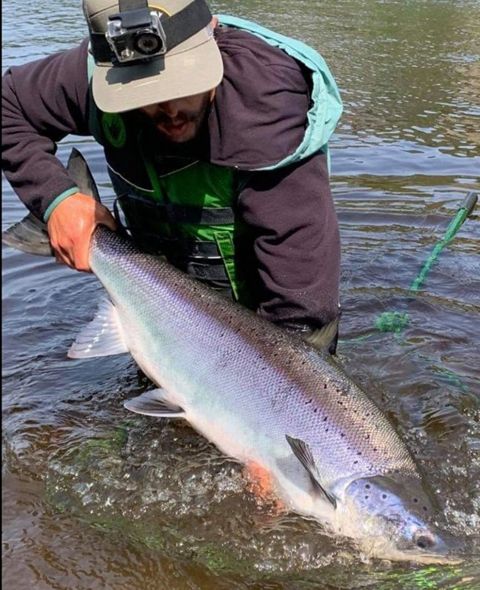
Don Ivany, ASF Director of Programs in Newfoundland and Labrador, writing yesterday:
In a nut shell – The angling season may have started off slow in NL this year but during the past few weeks things have really turned around and we have seen a significant increase in returns to many rivers in the province.
This is particularly true for rivers in the western half of the Island, and those in Labrador, where there have been good water levels and reasonably good water temperatures for much of the season.
For the past two weeks fishing has been very good on these rivers.
However, rivers in the eastern half of the Island, and many of those on the south coast of the Island, have had very little rain since the season began on June 1 , and continue to experience very low water levels and warm water temperatures.
Not surprisingly, returns are well below average for most of these rivers.
A number of rivers in the province have been closed to morning fishing only for environmental reasons and anglers are encouraged to check DFO’s web-site for the latest updates before fishing.
The good news is that anglers are reporting seeing large numbers of fish near the estuaries of many of these rivers and expect to see an influx of fish when water levels do eventually increase.
It is particularly encouraging to hear from many anglers this year reporting that there is a good mix of large fish along with grilse that appear larger than normal. The grilse this year are very thick and deep down through, suggesting they experienced good feeding conditions in the ocean.
There are also reports that capelin appear to be abundant around the province this year and this may explain why salmon appear to be in such good shape.
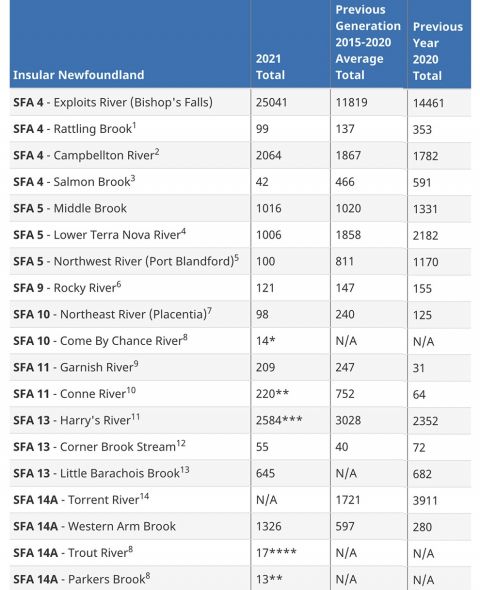
Western Newfoundland
Fishing conditions on many of the Bay St. George Rivers, and also on the Codroy River, have been fair during the past week. Anglers are reporting that fish are still moving through these rivers and a few fish are still being hooked. The DFO fishway counts indicate that 645 fish entered Little Barachois River which is on par with the 682 fish that were counted on the river last year for the same time period.
Fishing has been excellent for the past two weeks on the Upper Humber River at places like Big Falls and Little Falls, and we are also hearing reports that fishing is good further up-river at the headwaters.
Water temperatures were starting to creep up in these areas but cooler weather during the past few days have cooled things down again.
We are also receiving good reports on the Lower Humber (below Deer Lake) as well.
SPAWN Director, Scott Grant, and his angling companions report great fishing in this section of river during the past week. In addition to good numbers of grilse being caught, there has also been a number of large fish in the 15-20lb range being caught and released too.
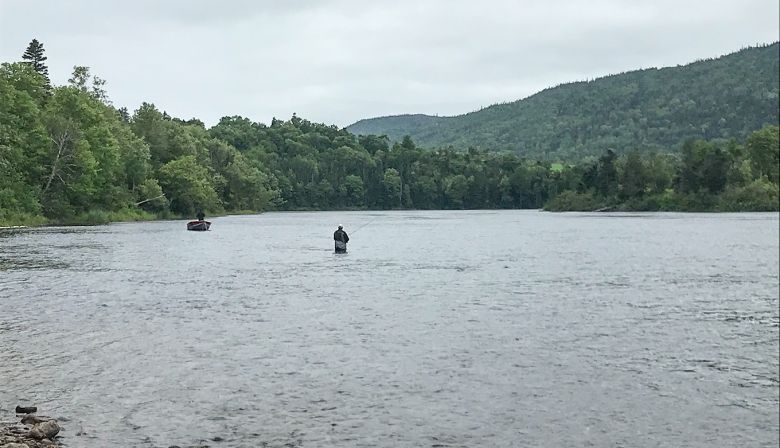
Reports indicate there is a good sign of fish on Lomond River where angling conditions are fair currently. However, reports indicate that angler crowding has been a bit of an issue on this relatively small river this past week.
Angling success has slowed down on the lower part of Main River (Sops Arm) as most fish have now migrated to the upper section of the river where fishing is very good. Water levels are on the high side on this river at the moment and water temperatures are falling.
Torrential rain north of the community of Daniels Harbour on July 9-10 resulted in extremely high water levels on most rivers in this area including Portland Creek, River of Ponds, Torrent River, Big East, Castor River, etc. Dave Vardy fished the Castor River all last week and reports a good run of fish went in these rivers on the rising water and as water levels started to recede there was fairly good fishing. However, fishing as slowed on the lower sections of the river as most fish are now in the upper sections of the river.
Tuckamore Lodge reports that there was excellent fishing on Main Brook (Salmon Brook) and the surrounding rivers last week, and there are still good numbers of fish in these rivers.
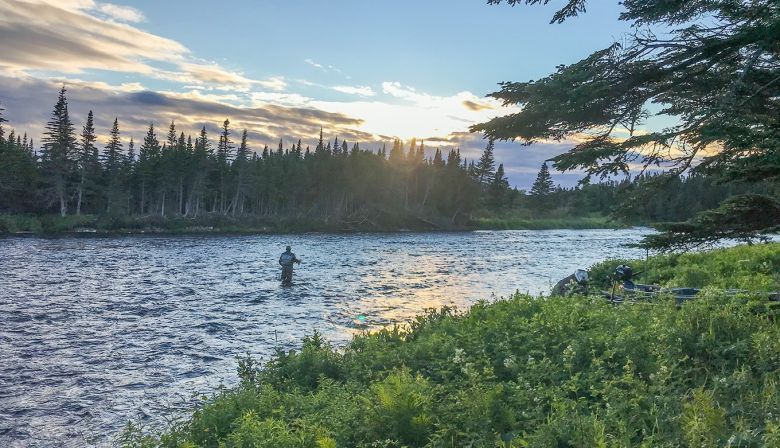
The south coast has experienced very low water levels and warm water conditions for much of the season and these conditions continue to persist. As a result reports indicate angling has been, and continues to be, fair at best. According to DFO Fishway counts up to July 18th, Conne River has only received 220 fish to date, and Garnish River has only received 209.
The Exploits River is having an excellent season so far this year and as of July 18 DFO reports that 25,041 salmon have passed through their fishway at Bishops Falls. This is up from 14,461 last year for the same time period.
Angling has been excellent on the Exploits this year and based on all reports there was still great fishing on the river last week.
Unfortunately, the ‘Mighty Gander’ has not been so lucky, mainly due to drought conditions all season. In fact, the river is currently running at only 12.5 cubic meters per second, which is exceptionally low. The good news is that water temperatures on the lower Gander, where most of the angling occurs, remains fairly cold and there is now a good sign of fish on the lower section of the river.
Calvin Francis, Chief of the Gander Bay Indian Band, reports that there is a really good sign of fish in this section of river currently and many of them are large. Reports also indicate there is a good sign of fish in Gander Bay still waiting to enter the system.
Ken McLean, reports that the Terra Nova River is very low at the moment and the water temperature is very warm. He reports that what fish are in the river currently are having difficulty migrating through the system. The DFO fishway counts indicate that only 1,006 salmon have entered the system as of July 18, compared to 2,182 for the same time period last year. However, reports indicate that there are also a lot of fish in the bay still waiting to enter the system.
The Campbellton River is doing much better and according to the DFO fishway counts 2064 fish have entered the system as of July 18th , compared to 1782 for the same time period last year. Reports also indicate there are still many fish in the bay waiting to enter the system.
Avalon Peninnsula
Angling conditions on the Avalon Peninsula Rivers continue to be poor with low water levels and warm water temperatures.
The following report from veteran angler Rick Maddigan sort of sums up the season in this region of the province to date. Quote….
“One of the worst years I have ever had. I had 2 weeks set aside for the Salmonier with my 8 yr. old grandson but it was too low on June 1 and it just got lower and lower. I had no desire to c and r in that water. He filled his tag though but the river was jigged to death. There were lots of fish.
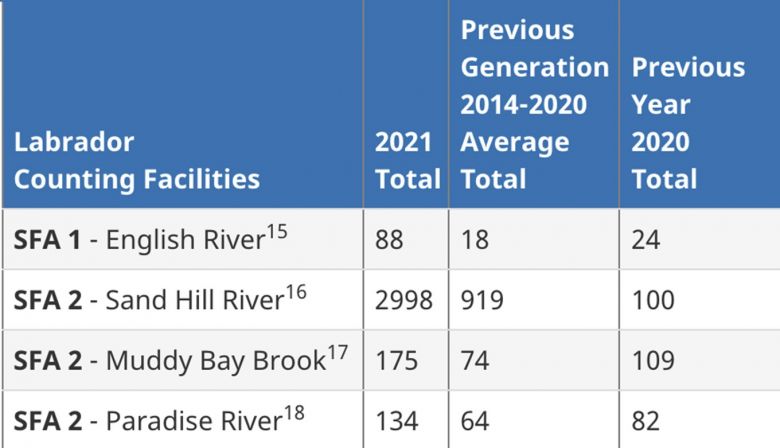
“Fishing on Hawke River had been good throughout the season, in spite of low water conditions recently. We have our first guests into Flowers River and are off to a very good start. Good numbers of fish and several in the over 20 lb class. In addition, I just left the Eagle River. Water is low, but the fishing was very good”.
It is worth nothing that the DFO fishway counts on all four monitored rivers in Labrador are up this year as of July 18, compared to the counts for the same time frame last season.

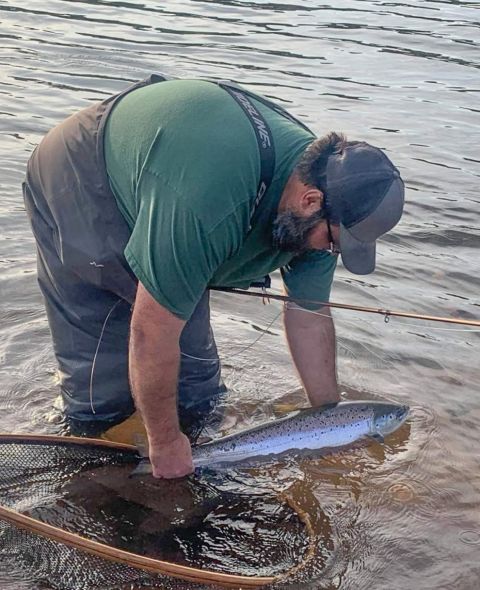
Margaree
Patrick Poirier writes earlier this week:
As water levels drop, the temperatures are slowly increasing. There are a few reports of over 20 C., but cooler nights are helping to keep water temperatures at a level safer for Atlantic salmon.
There are still fresh fish arriving daily, and good numbers of salmon being hooked. Another good dose of rain is in order to freshen up the Margaree, and lower temperatures.
On another note, be mindful of your surroundings, and respect nature – ” pack it in ,pack it out”. On a daily basis I’m leaving the river with beverage containers, and bundles of leader . Also use proper etiquette,and respect other fisher persons.
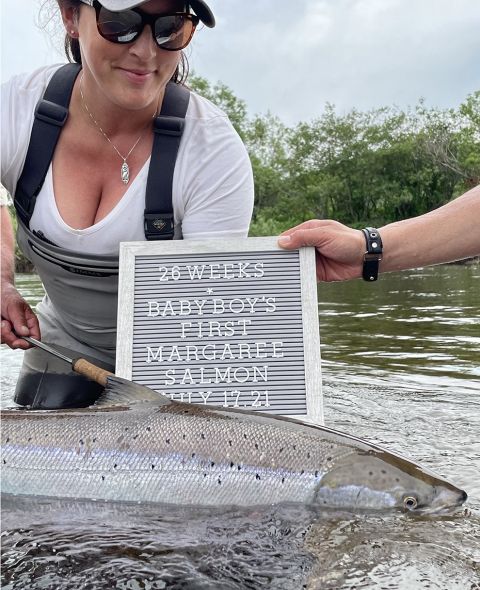
The first fish we encountered was a bright grilse, hooked by Robert Chiasson. He promptly offered his rod to nearby youngster, Joe, so he might experience fighting and landing his first Atlantic. Looking on, I thought about the happy times that await our family when we introduce our son to this community and sport.
Fly fishing while pregnant is an entirely new adventure.
Energy levels ebb and flow which makes trekking to and from the river much slower—or not manageable at all some days. I have done well up until now, but at 26 weeks the “wader waddle” is real.
On our second morning, after burning a fish the night before, I proceeded to raise three more on a dry. I pulled and… nothing!!! What in the world was I doing wrong?
Finally, I hooked up with a beautiful, bright eight-pounder that cartwheeled from the water several times. I had the fish close and thought landing her was a sure thing. But just as I was reeling, she gave one last kick. With my hand tight to the reel, the line snapped.
After a little break and a few passes through the same pool, another salmon came up and torpedoed my Wulff. This fish was a fair bit larger and soon my reel was screaming. Baby boy and I landed our first Margaree salmon together, with Daddy-to-be and great friends nearby. It was hands down the most special day I have had on the river, but I’m already looking forward to the memories we will make with our little one in tow.
The Cheticamp River Salmon Association writes:
We’re offering two introductory fly casting workshops next week, on July 27! Sign up for our morning (9-12) or afternoon (1-4) session and learn from master casting instructor Lewis Hinks and the CRSA’s President, certified casting instructor René Aucoin.
Many know Lewis Hinks as the now-retired ASF Director of Nova Scotia Programs, as well as being a master Atlantic salmon angler.

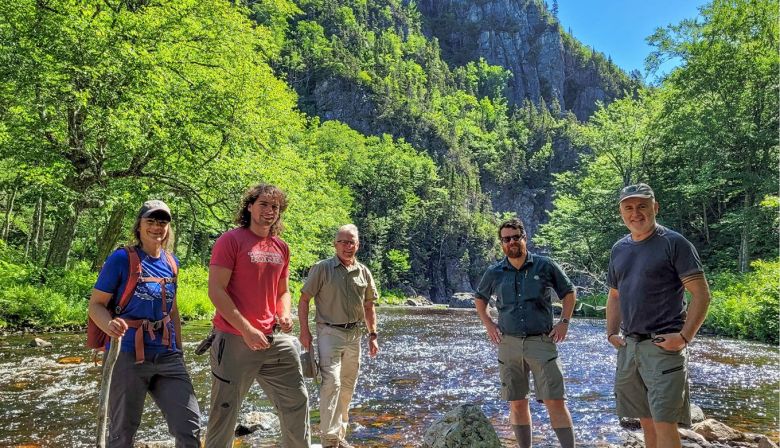
DFO has finally posted numbers for the Morgan Falls fishway, and they are low.
To July 15 there have been 11 large salmon and 138 grilse, compared with the 2013 to 2017 average of 37 large salmon and 81 grilse. It would appear that the LaHave, like many other salmon rivers this year is having larger numbers of grilse returning.
Sackville River
To July 15 there has been only 1 large salmon – but also 24 grilse, compared with the 2013 to 2017 average of 3 large salmon and 13 grilse. Again, a larger grilse run this year.
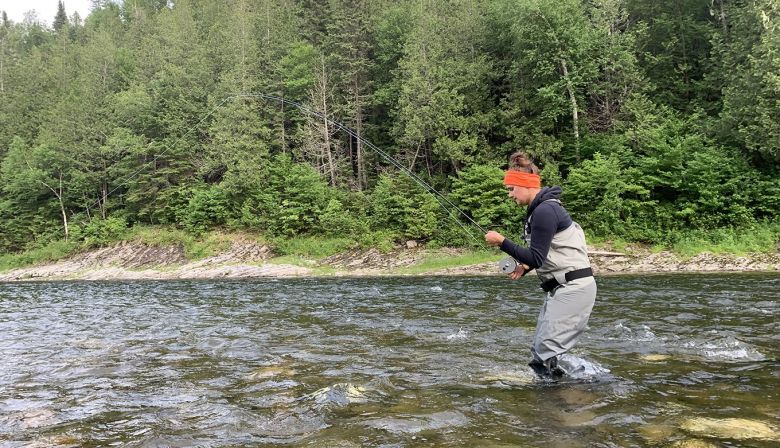
Restigouche
Jean-Daniel Savard of the Restigouche River Watershed Committee says:
‘’I went again to the 10-Mile Pool last week. The new barrier is functional and many salmons are in the sanctuary. Our pool wardens are taking a close look at them this summer to ensure their safety and we will release them when fall comes so they can spawn.
Also, even with the recent high temperatures, the conditions on the river remained fairly stable due low temperature during the night and some rain so the fishing activities could continue normally. ‘’
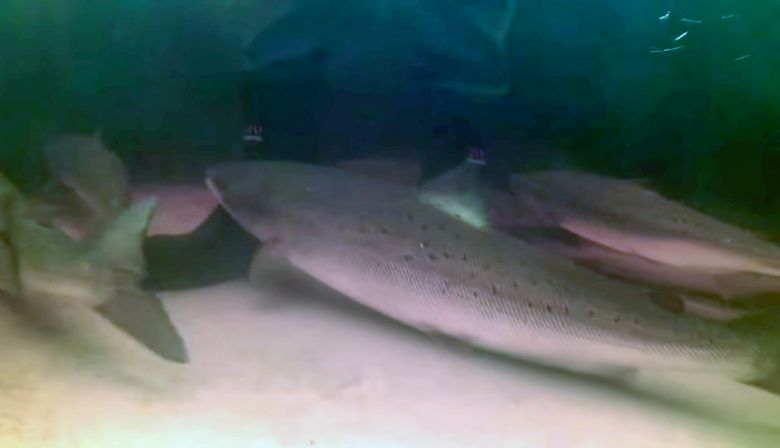
The Pabineau First Nation is reporting 67 grilse and 41 large salmon at the counting fence to July 14. They also note:
Please be informed that according to the warm water strategy in place for the Nepisiguit River, starting July 17, 2021, one section of the system will be closed to all angling between 11 AM to 6 AM the following day (morning fishing only) due to poor water conditions.
This fishing restriction will remain until conditions improve.
Notice to anglers, as well as detailed descriptions of the closure, are available on DFO’s recreational fisheries website at the following link:
http://www.glf.dfo-mpo.gc.ca/Gulf/FAM/Recreational-Fisheries/Salmon
Jacquet River
To July 18, there have been 12 grilse and 3 large salmon this year, vs 3 grilse and 4 large salmon in 2020.
St. John River
At last DFO has posted numbers for Mactaquac, but the numbers are very low. To July 15 there have been 44 large salmon and 161 grilse. As a reminder, from 1998 to 2002 the average was 680 large salmon and 1,408 grilse. And those numbers are a fraction of the return prior to the building of the Mactaquac Dam.
Nashwaak
To July 15 there have been 10 large salmon and 31 grilse. Accurate figures were not available for 2020.
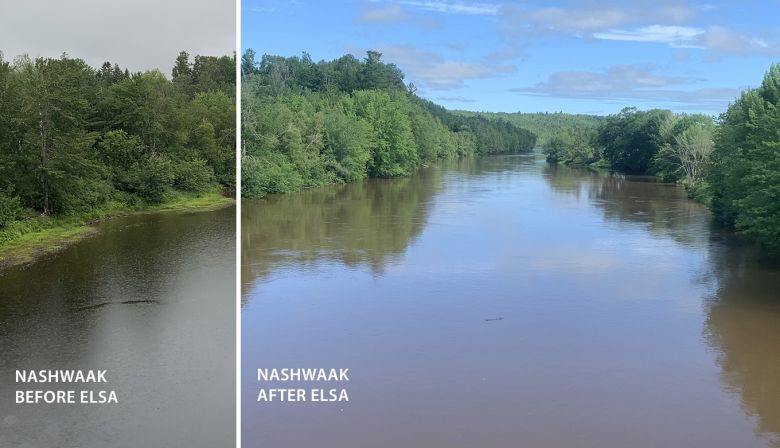
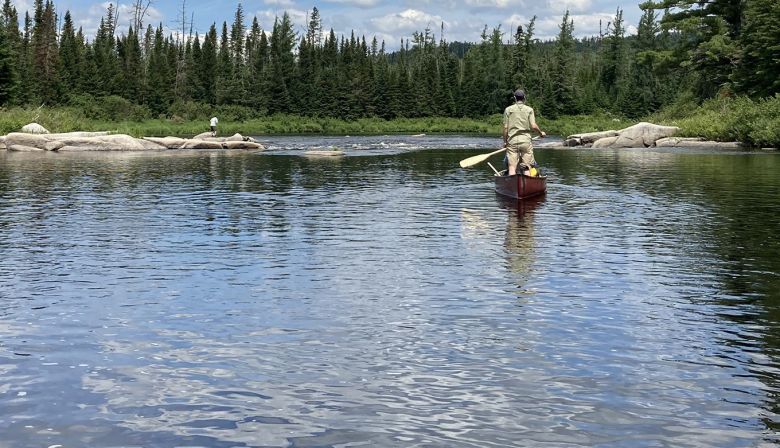
Brock Curtis of Curtis Miramichi Outfitters in Blackville notes:
All good here in Salmon Country.
River conditions are holding and many of the pools are producing good numbers of salmon and grilse on the fly.
I measured the water temperatures Tuesday afternoon and my thermometer showed 69 F. We are hearing from anglers coming into the tackle shop of hooking into salmon all along the river.
Even the tributaries here on the Southwest Miramichi are producing salmon and grilse. A few of our older guides consider this season one of the best in years. Most say they haven’t seen angling like this in over two decades. They mainly contribute it to the weekly cycle of rain we have been getting.
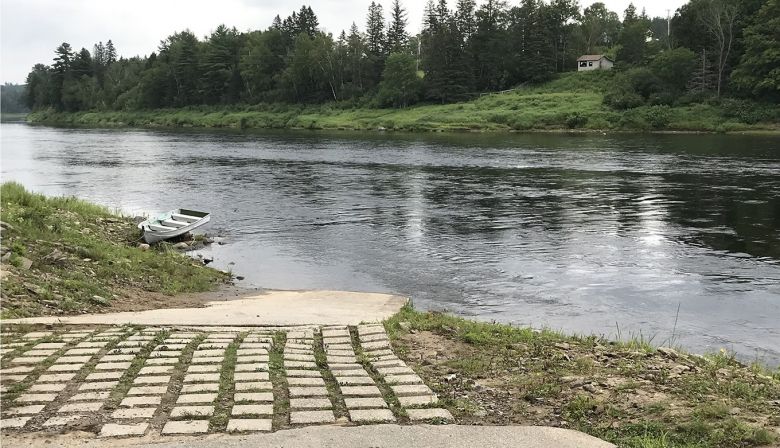
About the photo above:
The photo gives you an idea of river heights and a bit of the Coughlan Bar showing further out from the ramp.
I took this picture Tuesday afternoon when measuring the water temperatures. What I noticed though was how high the water levels were after our last heavy rain. When standing at the rivers edge on the ramp and looking up at the pavement the river at its highest level after the storm would have been 8 to 10 feet higher. Even at that height, two days after the storm, anglers were hooking into salmon.
It seems a steady run of salmon continues to move upriver and this has been happening for weeks now. Many first time anglers are hooking salmon.
Rain is in the forecast along with cooler temperatures. Conditions couldn’t be better heading into late July.
Dungarvon River Counting fence has 91 large salmon and 56 grilse to July 18, compared with 57 large salmon and 66 grilse in 2020 to the same date
The Millerton Trap Net on the Southwest Miramichi has had 152 large salmon and 641 grilse to July 15, compared with the 1998-2002 five-year average of 113 large salmon and 161 grilse in the 1998-2002 five-year average.
On the Northwest Miramichi the barrier had counted, by July 18, 82 large salmon and 143 grilse, compared with 112 large salmon and 59 grilse in 2020.
The Cassilis Trap Net on the Northwest Miramichi has had 76 large salmon and 220 grilse to July 15, compared with the 1998-2002 five-year average of 75 large salmon and 506 grilse.
Overall, the numbers are encouraging at this point in the summer.
Paul Elson Jr. says:
The Renous, Northwest Miramichi, and Little Southwest Miramichi are pretty low. We had a decent rain the last 24 hours that may improve things. We have hardly seen a salmon on the Northwest or Renous. The Little Southwest Miramichi is fishing okay. Not great numbers of fish but there are some salmon moving into the system and we are seeing more daily.
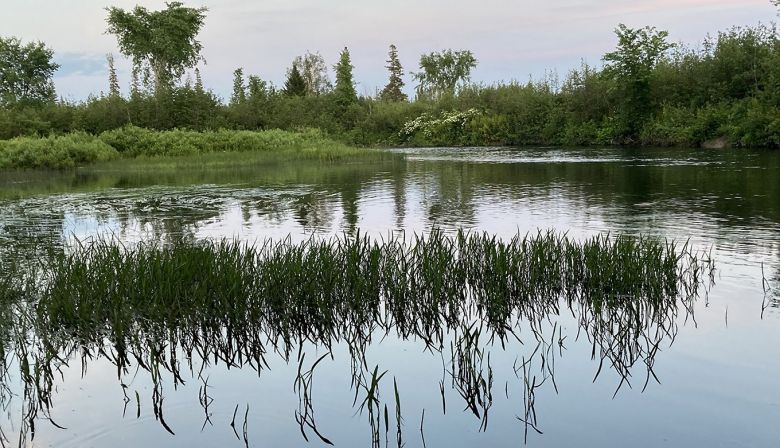
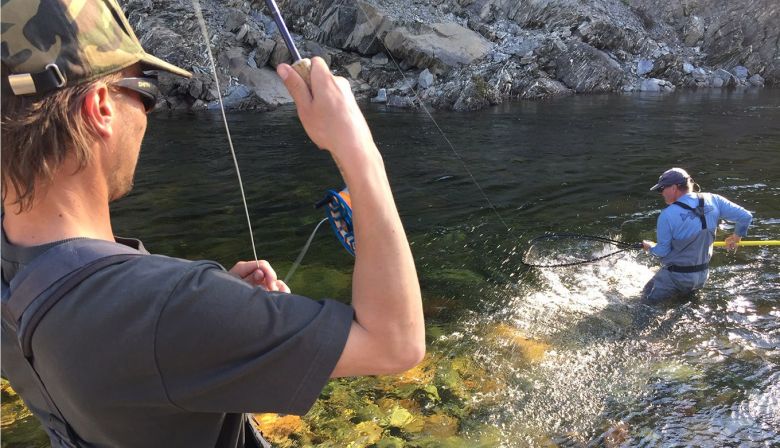
Rappel aux saumoniers pêchant les rivières du Québec, prenez le temps de rapporter vos prises et remise à l’eau afin d’avoir des statistiques précises et que les gestionnaires de rivière puissent calculer le succès de pêche avec précision.
Un rappel très important en provenance du MFFP :
** Les données utilisées dans ce rapport proviennent de divers sites Web, médias sociaux et des sources du gouvernement du Québec.

Rivière Cascapédia
Les statistiques de juin 2021 ont été publiées par la Société Cascapédia. Les résultats reflètent une saison où il y a évidemment moins d’abondance cette saison jusqu’à ce jour.
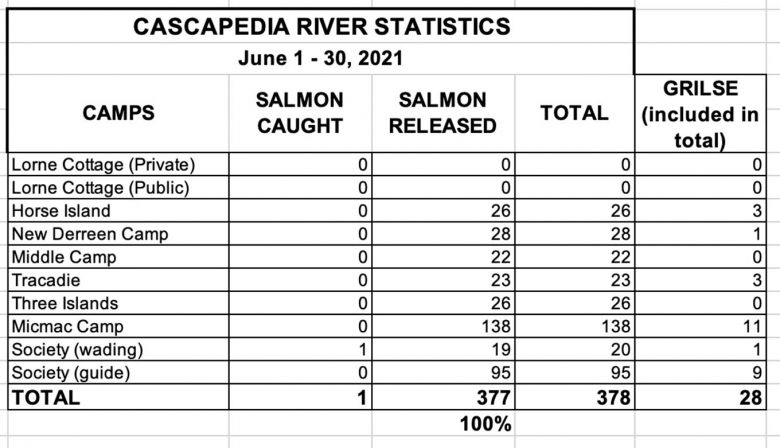
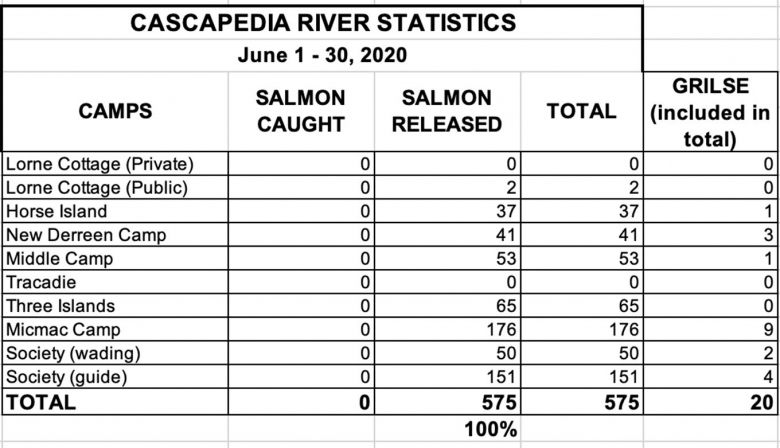
Rivière Godbout
Au 18 juillet la Zec Godbout fait rapport que 693 poissons (435 saumons et 258 madeleineaux) ont été comptés depuis l’ouverture de la passe migratoire le 23 juin dernier. À pareille date en 2020, 663 poissons avaient franchi la passe migratoire, soit 380 saumons et 283 madeleineaux.
Depuis le début de la saison, les pêcheurs sportifs ont déclaré des captures totalisant 139 poissons, dont 42 saumons remis à l’eau, 63 madeleineaux récoltés et 34 madeleineaux remis à l’eau.
Rivières York, Dartmouth, Saint-Jean
Voici les résultats affichés au 18 juillet sur le site de la Zec Gaspé jusqu’à ce jour en 2021.
York 351 captures (incluant les remises à l’eau) 3 165 jours-pêche (2 366 en 2020)
Dartmouth 189 captures (incluant les remises à l’eau) 977 jours-pêche (779 en 2020)
Saint-Jean 126 captures (incluant es remises à l’eau) 421 jours pêche (377 en 2020)
Visiter le https://saumongaspe.com/riviere-york/declaration-de-remise-a-leau.html
afin d’enregistrer une remise à l’eau.
Pour avoir un aperçu d’un décompte en apnée dans la rivière Saint-Jean, cliquer le lien suivant : https://www.facebook.com/watch/?v=1072851369836718
Rivière Causapscal
La saison de pêche sportive sur la Causapscal s’est terminée le 15 juillet. 78 prises ont déclaré en 2021, dont 28 qui ont été relâchés afin de poursuivre leur migration vers la période de la fraie.
Pendant la saison 2020, 140 prises, dont 55 remis à l’eau avait fut déclaré par les pêcheurs sportifs. Le total comprenait 55 saumons qui ont été remis à l’eau.
En fin de saison au 15 juillet 2019, 181 prises fut enregistré dont 70 saumons remis à l’eau.
Les chiffres de fin de saison en 2018 démontraient que 166 prises furent déclarées, dont 63 saumons relâchés.

Cumulativement au 20 juillet 2021, la capture de 347 poissons (225 remises à l’eau et 122 madeleineaux récoltés) a été enregistrée avec la CGRMP.
En 2020, à pareille date, 597 captures étaient inscrites comprenant 455 remises à l’eau et la récolte de 136 madeleineaux.
En 2019, cumulativement au 21 juillet, 608 prises furent déclarées (415 poissons relâchés et 193 madeleineaux récoltés).
Rivière Matane
1 154 poissons ont franchi la passe migratoire (681 saumons et 873 madeleineaux) en date du 19 juillet depuis le 15 juin 2021. Pour leur part, les pêcheurs sportifs ont capturé 290 poissons, dont 154 remises à l’eau et la récolte de 136 madeleineaux.
Au 19 juillet 2020, 1 469 poissons (1 050 saumons et 419 madeleineaux) furent dénombrés par le biais de la passe migratoire.
Rivière Mitis
Jusqu’au 20 juillet, 1 592 poissons (738 saumons et 854 madeleineaux) ont franchi le piège de capture. Pour la rivière Mitis et Mistigougèche, 298 poissons ont été capturés dont 149 remises à l’eau et 145 madeleineaux furent récoltés.
Au 20 juillet 2020, les gestionnaires de la Mitis étaient plus que satisfaits des résultats de montaison et la performance du nouveau piège de capture. À cette date, 1 117 poissons furent transportés en aval du site de capture, dont 613 grands saumons et 504 madeleineaux.
Rivière Madeleine
Le 18 juillet, le décompte à ce jour indique que 939 poissons (481 saumons et 458 madeleineaux) ont franchi la passe migratoire.
Cumulativement au 20 juillet 2020, 1 000 poissons avaient migré par le biais de la passe migratoire, dont (584 grands saumons et 416 madeleineaux).
À pareille date en 2019, cumulativement, 383 poissons furent dénombrés, dont 277 grands saumons et 106 madeleineaux.
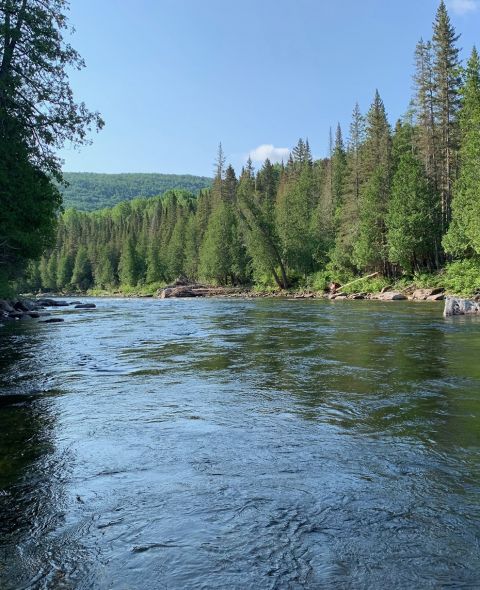
Angling results have slowed down in the last week due to most rivers still dealing with low water levels and higher temperatures. Migration numbers continue to be very encouraging on rivers such as the Matane, Madeleine, and the Mitis. The substantial increase in the number of grilse seems to be a province wide occurrence this season compared to last few years. Mid-season assessments will take place next week to determine if a harvest of large salmon can take place during the second half of the 2021 season.
Reminder to anglers fishing Quebec Rivers: take the time to report your releases to have the most accurate angling statistics so the river managers to accurately calculate angling success.
Tight Lines!
** Data used in this report are sourced from various river websites, social media, and Quebec government sources.
Cascapedia river
The Cascapedia society published the June statistics. Results reflect an obvious situation of lower abundance to date.

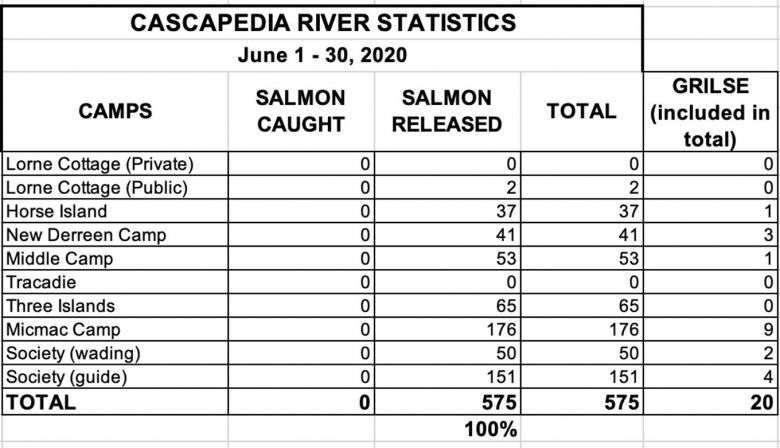
The Godbout Zec is reporting 693 fish (435 salmon and 258 grilse) have migrated through the fishway since June 23rd. To the same date during the 2020 season, 380 salmon and 283 grilse had been counted for a total of 663.
Since June 1st, 2021, sport anglers have landed 139 fish (42 salmon and 34 grilse have been released and 63 grilse were harvested).
York, Dartmouth, Saint-Jean Rivers
For the 2021 season to July 17th, the Gaspé Zec is reporting the following results:
York 351 captures (includes releases) 3,165 rod days (2,366 in 2020)
Dartmouth 189 captures (includes releases) 977 rod days (779 in 2020)
Saint-Jean 126 captures (includes releases) 421 rod days (377 in 2020)
To register the release of a fish please visit https://saumongaspe.com/riviere-york/declaration-de-remise-a-leau.html.
With mid-season assessments approaching and to get an idea of what it is like to count fish in the Saint-Jean River: click on this link https://www.facebook.com/watch/?v=1072851369836718
Causapscal River
Another season has come to an end as of July 15th. For the season, a total of 78 fish were reported landed which includes 28 released to continue their migration.
For the 2020 season, 140 fish were reported landed of which 55 were released. In 2019, anglers landed 181 fish which included 70 releases. 166 fish were landed in 2018 that included 63 releases.
Matapedia River
To July 20th for the season, 347 fish (225 releases and 122 grilse harvested) were landed by anglers.
571 salmon had been reported landed including 445 released and 126 grilse harvested at the same date in 2020.
During the 2019 season, to July 21st, 608 fish had been landed (415 released and 193 grilse harvested).
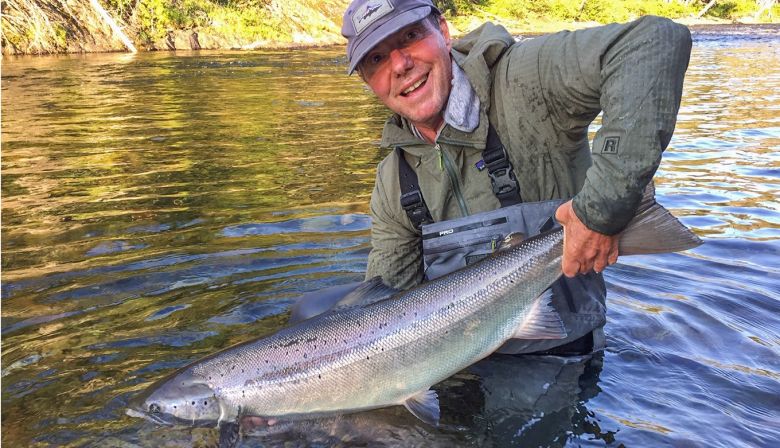
Madeleine River
As of July 18th, 2021, 939 fish (481 salmon and 458 grilse) have been counted through the underground fishway.
Last year, to July 20th, 1,00 fish had been counted migrating through the fishway (584 large salmon and 416 grilse).
To the same date in 2019 when a total of 383 fish (277 large salmon and 106 grilse) had been counted.
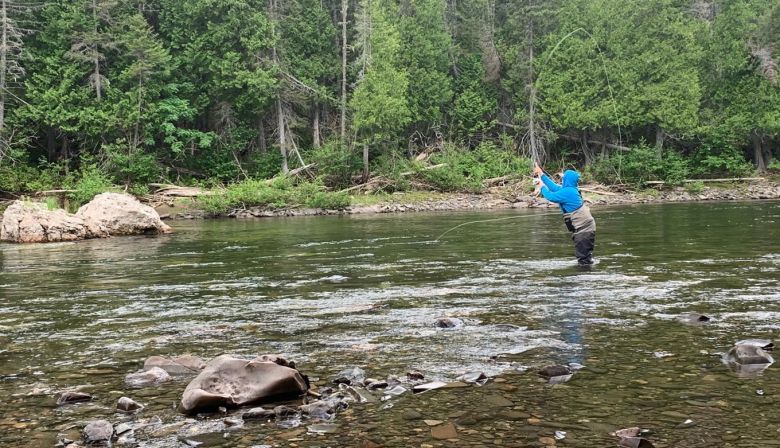
As of July 19th, for the season, 1,154 fish (681 salmon and 873 grilse) have been counted since June 15th. Salmon anglers have reported releasing 154 salmon and grilse and harvesting 136 grilse for a total of 290.
1,469 fish (1,050 salmon and 419 grilse) had migrated through the fishway to July 19th, 2020.
To July 19th, 2019, 807 salmon and 345 grilse had been counted for total of 1,152.
Mitis River
As of July 20th, 1,592 fish (738 salmon and 854 grilse) have been counted. This season, anglers fishing both the Mitis and its main tributary, the Mistigougèche have landed 298 fish (149 releases and 145 grilse harvested).
To July 20th, 2020, at total of 1,117 fish were transported upriver (613 large salmon and 504 grilse). Cumulatively for the same date, 58 salmon had been released and 54 grilse harvested. As of July 22nd, 2019, for the season, 25 salmon had been released and 27 grilse harvested.
In 2019 at the end of season to September 30th, 976 fish (503 salmon 473 grilse) had been relocated upriver.
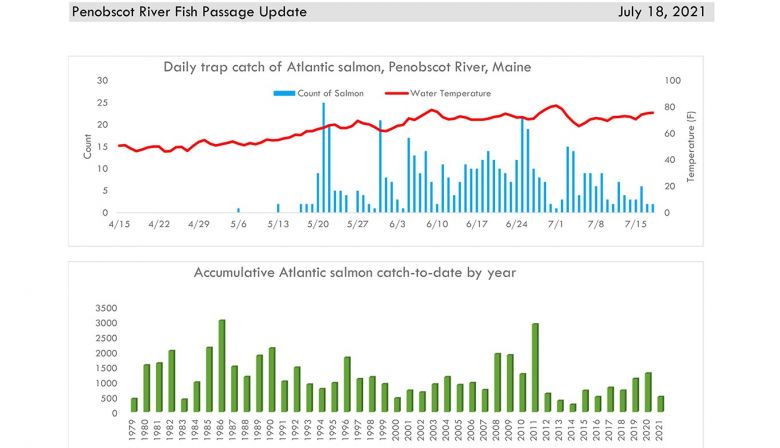
John Burrows, ASF’s Executive Director of U.S. Programs, says:
In general, we’ve gotten a good amount of rain and cooler weather the last few weeks.
The higher elevation, inland areas haven’t received nearly as much rain as the coastal areas, so river flows on large river like Kennebec and Penobscot, while improved over the record lows, are still way below the median.
Adult salmon are trickling in. By this point in the season, we are usually well beyond the mid-point of the runs, so the migration will be down for the year unless there is a big push of fish in the next week or so and/or in the fall.
Penobscot
There have been 502 Atlantic salmon at the Milford Fishlift as of July 18, 2021. While these numbers are nowhere near the excellent returns in 2020, they are still good.
Kennebec
Sunday’s rain event raised the Kennebec up to ~3,200 cfs but is working its way back down toward the historical low (2,330 cfs in 2007) and currently at 2,800 cfs.
Temperatures at the Lockwood fish lift have been ~21.5°C on average all week. One multi-sea winter salmon was caught this week in the Lockwood fish lift.
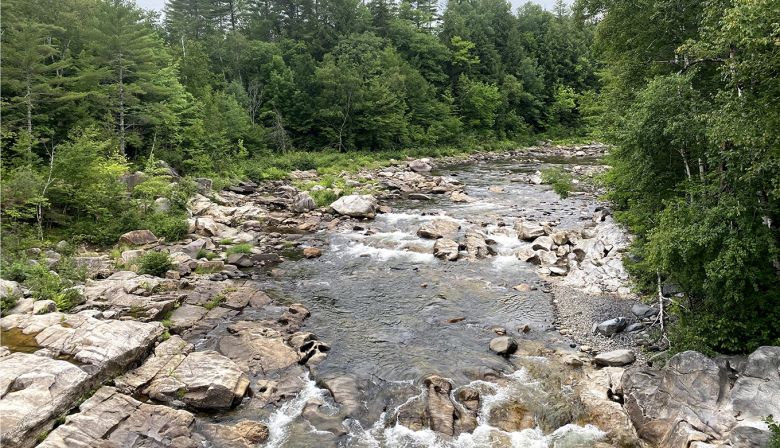
Narraguagus
Colby Bruchs, Maine DMR Biologist, notes:
Three new salmon were captured this week, up to 19 July. This brings the season total to 12 large salmon and three grilse.
Two were multi-sea-winter salmon returns from smolt stocking and one was a naturally-reared grilse.
Water temperature increased to above 23 C. this week.
Discharge has steadily declined post-Elsa but remains around 150 cubic feet per second, which is roughly 30 CFS above median.
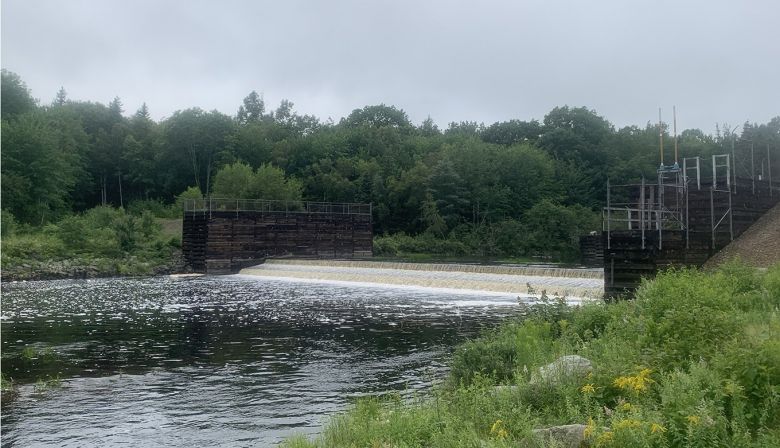
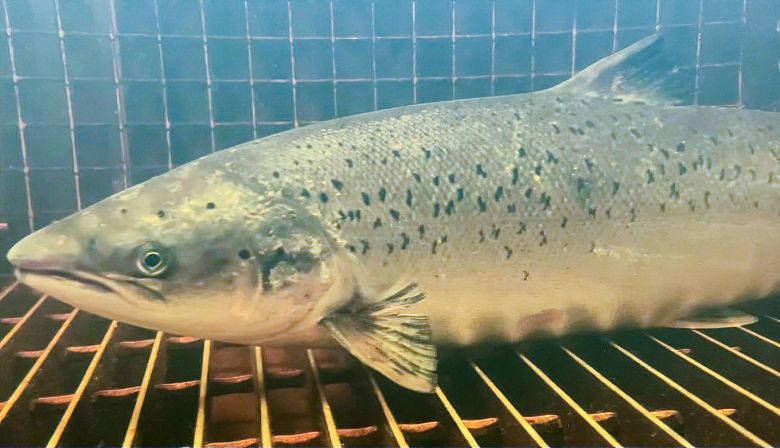
We have reason to hope for getting through the summer, and hopefully Atlantic salmon will continue to return from their far migrations at sea.